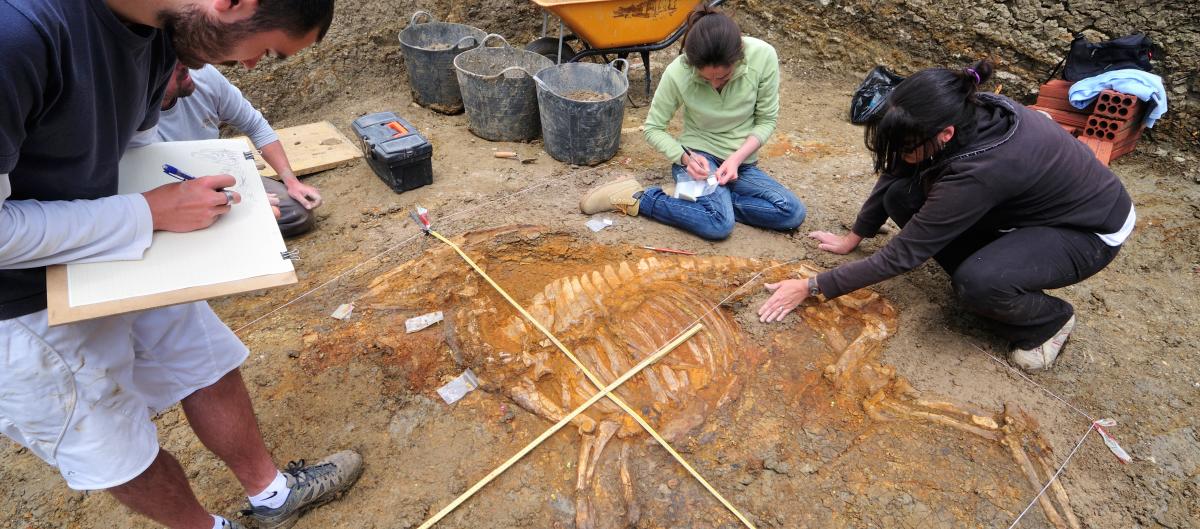Human Palaeoecology in the Plio-Pleistocene

Title: Paleoecology of Pliocene and Pleistocene and Human Dispersals (PalHum)
Coordinator: Dr. Isabel Cáceres![]()
Call: Ajuts per donar suport a les activitats dels grups de recerca de Catalunya (SGR-Cat 2021)
Funder: Agència de Gestió d'Ajuts Universitaris i de Recerca (AGAUR)
Period: 01/01/2022 - 31/12/2024
Reference Code: 2021 SGR 01238
Researchers: Dr. Jordi Agustí, Dr. Deborah Barsky, Dr. Hugues-Alexandre Blain, Dr. Gerard Campeny, Dr. Antoni Canals, Dr. Bruno Gómez de Soler, Dr. Löic Lebreton, Dr. Weiya Li, Dr. Juan Manuel López, Dr. Bienvenido Martínez-Navarro, Dr. Alicia Muñoz del Pozo, Dr. Carmen Nuñez-Lahuerta, Dr. Pedro Piñero, Dr. Iván Rey Rodríguez, Dr. Robert Sala, Dr. Stefania Titton.
PhD students: Héctor del Valle, Federica Grandi, Almudena Martínez Monzón, Christián Sánchez Bandera.
Support to research staff: Bernat Sentís, Marta Fontanals, Melanie Lex, Dr. Patricia Marín, Elena Moreno Ribas, Miguel Ángel Soares Remiseiro.
Collaborations: Dr. Ana Fagoaga, Dr. Sandra Bañuls Cardona, Dr. Tsegai Medin, F.J. García Vadillo, Adriana Linares, Nadia Saidani.
The objectives of PalHum focus on establishing the context of the Pliocene and Pleistocene human dispersals in the Mediterranean area from a multiple approach: A) Assessing how cyclical global climatic changes acted as a factor influencing the chronology and geography of hominin dispersals; B) hominins-carnivores coevolution and interactions and their implication for dispersal/subsistence; C) the study of technological behaviour and evolution (Oldowan, Acheulean and Mousterian) and their implications for population replacement and/or cultural transmission across the Mediterranean; D) Hominin subsistence strategies and sites formation processes; and E) the social and economic impact of Plio-Pleistocene scientific research. All these aspects, climate evolution, associated faunal interactions, techno-cultural innovation, and subsistence strategies, have acted as significant drivers in the different episodes of human dispersal from the Pliocene to Middle and Upper Pleistocene. The main research topics are:
A. Human and faunal dispersals during the Pliocene and Pleistocene: Tempo and Mode
A1. Pliocene and Pleistocene Eurasian faunal dispersals
A2. Biochronology of hominin settlements into Mediterranean area and abroad
A3. Human occupations in Eurasia, Northern Africa, and Horn of Africa
A4. Paleoenvironmental and paleoclimatic context of hominin dispersals
B. Hominins-Carnivores interactions
B1. Hominins-Sabertooths coevolution (Meganteron whitei)
B2. Hyenas-Hominins interactions (Pachycrocuta brevirostris, Crocuta crocuta and Hyena hyena)
B3. Interaction with social carnivores (Lycaon lycaonoides)
C. Early Technological Behavior (Oldowan, Acheulean and Early Middle Paleolithic) and technological evolution
C1. Stone Tools (Raw Materials, Lithic Technology, Use-Wear/Experimental Archaeology)
C2. Information Systems in archaeo-paleontological sites: social behaviour and spatial distribution
C3. Dispersal/Transmission of techno-cultural innovations
D. Hominin Subsistence strategies and site formation
D1. Evolution of hominin faunal exploitation and subsistence strategies along the Pleistocene
D2. Fossilization processes and site formation (Bone Surface Modifications, Bone diagenesis)
E. Heritagization of the archaeo-paleontological record
E1. Non formal scientific education in geosciences and the archaeological record as a source of young public engagement of science
E2. Monitoring the cultural equipment, including how to communicate or transfer archaeo-paleontological contents in order to build sustainable infrastructures.
PalHum members will pursue their objectives through the application of a multidisciplinary approach in a number of long stratigraphical sections and key sites, from Eastern Africa to Western Eurasia and the Mediterranean Basin. Most of these sites have long been the research subject of the group members (either as a Principal Investigator or as participants in the fieldwork and/or study materials), in many cases in collaboration with researchers and research institutions in countries where they are located, that allow us to cover other disciplines beyond the composition of this group.
To achieve these objectives, numerous sites from Europe, Asia and Africa are investigated in collaboration with researchers from national and international institutions.
The most outstanding sites are:
- Late Pliocene: Camp dels Ninots (Spain), Baza (Spain), Na Burguesa (Spain).
- Early Pleistocene: Venta Micena, Barranco León and Fuente Nueva 3 (Spain), Quibas (Spain), Cueva Negra del Estrecho del Rio Quipar (Spain), La Boella (Spain), Atapuerca (Spain), Bois de Riquet (France), Pirro Nord (Italy), Aïn Beni Mathar and Guefaït Basin (Morocco), Oued Sarrat Basin (Tunisia), Tighennif (Algeria), Ain Boucherit-El-Kherba-Ain Hanech (Argelia), Dmanisi (Georgia), Ubeidiya (Israel), Engel Ela-Ramud Basin and Danakil Depression (Eritrea), Gona (Afar Region, Ethiopia).
- Middle-Early Late Pleistocene: Cova dels Xaragalls (Spain), Santa Ana Cave (Spain), Atapuerca (Spain), La Cansaladeta (Spain), Cova Eirós (Spain), N’gaous (Algeria), Caune de l’Arago (France), Grotte du Lazaret (France), Gruta da Oliveira (Portugal), Figueira Brava (Portugal).
Concerning knowledge transfer, the PalHum Group, based on its valorization of the scientific results guidelines, will continue working to consolidate and strengthen the ongoing transfer actions related with heritage enhancement of paleontological and archaeological sites, in Catalonia and abroad. Currently, it is co-leadership with the City council of Caldes de Malavella, the Camp dels Ninots archeopaleontological site valorization, has led to the creation of the new visitor’s center AQUAE (www.visitcaldes.cat/espai-aquae/) and interpretative route at the site. Our group will continue providing scientific advice, scientific-technical reports and supplying of contents and activities to the management and touristic dynamization of this cultural heritage. In this sense, in forthcoming years, we plan to complete the interpretative route at this archeopaleontological site with news pathways and didactical signs.
Likewise, the research results obtained by our group in relation with the archaeological sites of the Guadix-Baza Basin (Granada, Andalusia) will continue to provide scientific assessment updating contents to the Centro de Interpretación de los Primeros Pobladores de Europa (Orce, Granada) (www.orce.es/museo-primeros-pobladores-de-europa/) and Paleomágina (Bedmar, Jaén) (www.instagram.com/paleomagina/) through scientific assessment. Similarly, the group members will continue feeding the Atapuerca System through scientific advice, guides training, activities and supplying of contents, collaborating with its stakeholders such as Museo de la Evolución Humana and Fundación Atapuerca (https://www.museoevolucionhumana.com). In addition, on the international level, our group will follow up on the research and knowledge transfer collaborations for the development of the National Museum of Georgia (Caucasus) and Université Mohammed Premier Oujda for valorization of Dmanisi archaeological sites and the archaeological heritage of Eastern Morocco.

